In the Weeds: Vines

Vining plants like the Oriental Bittersweet showing its fall colors above are capable of choking out the planted species in a vegetated stormwater system. Click on the plant names below to open a drop-down with images and more information about each of these common GI invaders.
Scientific name: Solanum dulcamara
Status: Invasive
This invasive vine has delicate blue-purple and yellow flowers that develop into bright red berries. Some of its leaves are compound (see third image below) and some of them are simple (see fourth image below). It grows along stream banks, small waterways, and other open wet areas.




Photo credit: (First) Rob Routledge, Sault College, Bugwood.org, (second, third, fourth) Randall G. Prostak, University of Massachusetts Extension.
Scientific name: Hedera helix
Status: Invasive
This is a climbing ivy with dark green leaves and round bunches of small yellow-green flowers. Leaf shape simplifies when plant reaches maturity. Compare circled leaves: The first photo is of an immature plant and the second is of a mature one.




Photo credit: (First) David Stephens, Bugwood.org, (second) James H. Miller, USDA Forest Service, Bugwood.org, (third) Richard Gardner, UMES, Bugwood.org, (fourth) Leslie J. Mehrhoff, University of Connecticut, Bugwood.org.
Scientific name: Convolvulus arvensis
Status: Invasive
Flowers look very much like those of a morning-glory but are smaller and white or whitish-pink. This plant aggressively invades disturbed sites; it can climb up as well as grow along the ground. Leaves are alternate.


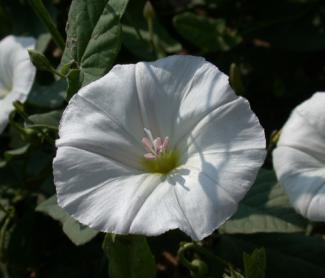

Photo credit: Randall G. Prostak, University of Massachusetts Extension.
Scientific name: Vitis labrusca
Status: Native and weedy
This native vine has many brown-gray hairs on the underside of its leaves. Fine tendrils often sprout from where the leaf meets the stem. Leaves are arranged alternate and pith is brown. Check the color of the pith by snapping a small branch.




Photo credit: (First, second) Randall G. Prostak, University of Massachusetts Extension, (third) Ohio State Weed Lab , The Ohio State University, Bugwood.org, (fourth) Robert Vidéki, Doronicum Kft., Bugwood.org.
Scientific name: Smilax rotundifolia
Status: Native and weedy
This common native vine has bright green, alternate oval leaves and dark green prickles. It forms thickets in a wide range of disturbed habitats. The blue-black berries are eaten by birds.
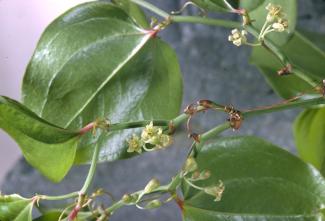


Scientific name: Lonicera japonica
Status: Invasive
This vine produces many very fragrant white and pale yellow flowers. It has dark-purple berries favored by birds. Leaves are simple and arranged opposite. Note that the leaves can be either lobed or unlobed.

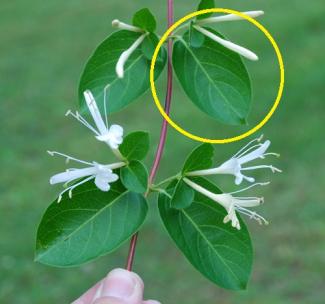



Photo credit: Randall G. Prostak, University of Massachusetts Extension.
Scientific name: Persicaria perfoliata/Polygonum perfoliatum
Status: Invasive
Found most often in full sun but sometimes in shade. Root system is shallow and fine. Leaf shape is of an equilateral triangle except for cup-shaped leaf under flower. Leaf undersides and stems are barbed. Berries are blue-black.




Photo credit: Leslie J. Mehrhoff, University of Connecticut, Bugwood.org.
Celastrus orbiculatus
Invasive
A woody vine that can grow up into forest canopies, sometimes damaging or killing trees. Leaves are rounded and bluntly toothed. Small green flowers give way to red fruit that remain on the vine after fall leaf-drop. The roots are orange in color (see second image).
Poison Ivy
Toxicodendron radicans
Native and weedy
This native plant acts as a vine and climbs via fibrous, aerial roots in the shade. It takes on a more shrub-like shape when growing in open coastal areas. Leaves are glossy and grow in groups of three. Thrives under many soil conditions. CAUTION: Wear protective clothing to guard against toxic oil on leaves and stems. Never burn plants.





Photo credit: Randall G. Prostak, University of Massachusetts Extension.
Porcelain-Berry/Amur Peppervine
Ampelopsis glandulosa
Invasive
This woody vine of the grape family climbs with tendrils. Leaves are alternate, dark-green and are similar in shape to maple leaves. Found in disturbed habitat, often at edges between shady and sunny areas. Observe white pith to distinguish from native look-alikes.






Photo credit: (First, second, third) Leslie J. Mehrhoff, University of Connecticut, Bugwood.org, (fourth, fifth, sixth) Randall G. Prostak, University of Massachusetts Extension.
Black Swallowwort
Vincetoxicum nigrum/Cynanchum nigrum
Invasive
A creeping vine with small, five-petaled velvety flowers that form a cup-shape. Leaves are arranged opposite. The fruit is a sizeable green pod.
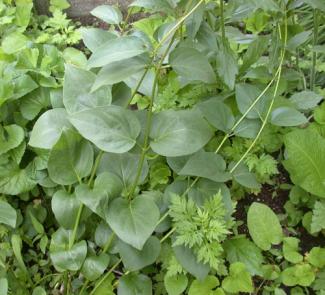


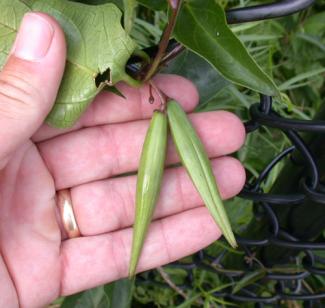

Photo credit: (First, third, fifth) Randall G. Prostak, University of Massachusetts Extension, (second) Ansel Oommen, Bugwood.org, (fourth, sixth) Leslie J. Mehrhoff, University of Connecticut, Bugwood.org.
Pale Swallowwort
Vincetoxicum rossicum/Cynanchum rossicum
Invasive
Flowers are lighter and petals are finer than Black swallowwort. Leaves are opposite. Can form monocultures in disturbed areas. It is especially competitive in shallow soils over limestone.





Photo credit: (First, second, fourth) Randall G. Prostak, University of Massachusetts Extension, (third, fifth) Leslie J. Mehrhoff, University of Connecticut, Bugwood.org.
Sweet Autumn Clematis
Clematis terniflora
Invasive
This vine will climb as well as cover ground. It has many white flowers in the fall giving way to seeds that have distinct feathery, silvery tails for hitching a ride on a breeze. Tell apart from native kinds of clematis because the invasive has 3-5 leaflets that are glossy and have smooth edges while native has 3 leaflets with deeply toothed edges.Go here to see a comparison of C. virginiana leaves compared to C. terniflora leaves.





Photo credit: (First, fourth, fifth, sixth) Leslie J. Mehrhoff, University of Connecticut, Bugwood.org, (second) Chris Evans, University of Illinois, Bugwood.org, (third) Karan A. Rawlins, University of Georgia, Bugwood.org.
Parthenocissus quinquefolia
Native and weedy
This common native plant has five-part compound leaves of glossy-green. It uses tendrils for climbing, and birds eat the dark fruits that grow on red stems. Edge of leaf has teeth.

Chinese Wisteria
Wisteria sinensis
Invasive
This distinctive vine prefers full sun. It has compound dark green leaves and produces 6-12” clusters of mildly fragrant flowers. With unchecked growth stems can become trunk-like and strangle other plants.

Japanese Wisteria
Wisteria floribunda
Invasive
Japanese wisteria differs from Chinese wisteria in its brighter green leaves and longer (12-18 inches) clusters of very fragrant flowers. Both species sport large, long seed pods (see Chinese wisteria), and compound leaves.
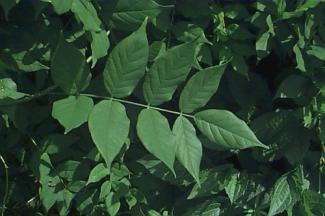
Descriptions for Bittersweet Nightshade, English Ivy, Field Bindweed, Fox Grape, Greenbriar, Japanese Honeysuckle, Sweet-Autumn Clematis, Black Swallowwort, Pale Swallowwort, and Virginia Creeper obtained from New England Wild Flower Society. www.newenglandwild.org & www.gobotany.newenglandwild.org
Descriptions for Mile-a-Minute Vine, Oriental Bittersweet, Poison Ivy, and Porcelain-Berry referenced from https://extension.umd.edu/hgic
Description for Chinese Wisteria referenced from https://plants.ces.ncsu.edu/plants/all/wisteria-sinensis/
Description for Japanese Wisteria referenced from https://plants.ces.ncsu.edu/plants/vines/wisteria-floribunda/
